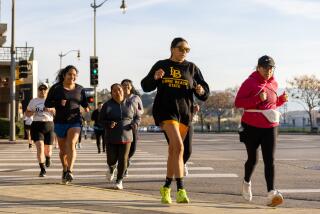Barefoot runner Caity McCardell ready to put her soles on the line
- Share via
Caity McCardell was running along the Huntington Beach bike path and blithely talking away when she abruptly went silent. Her face grew taut; her eyes narrowed.
She had hit a rocky patch of the blacktop. The thing was, she was running barefoot.
Later in the workout, her coach, Todd Byers, running barefoot beside her, reminded her of the proper form.
“Use your knees as your suspension, relax and just absorb whatever you’re feeling into the rest of your body,” said Byers, better known as Barefoot Todd.
This kind of running, McCardell said afterward, is like “getting a massage where it becomes a bit much and you want to tell the therapist to ease up, but you relax and it feels really good.”
A recent convert to the world of shoeless running, she has signed up for Sunday’s Los Angeles Marathon — the 26.2-mile race that begins at Dodger Stadium and finishes in Santa Monica. It will be her first marathon.
Yes, she will be barefoot. And no, she hasn’t told her mother.
“What I’m afraid I’d hear is, ‘Caity you can’t do that, Caity it’s unsafe,’” McCardell said.
Barefoot running is not new. Both Ethiopia’s Abebe Bikila, who won the 1960 Olympic marathon, and South Africa’s Zola Budd, who became an Olympic track star in the 1980s, had grown up running without shoes.
In recent years, studies have shown that running barefoot leads to fewer injuries. That has prompted more and more people to abandon their cushioned track shoes — the L.A. chapter of the international Barefoot Runners Society boasts 89 members now.
Daniel Lieberman, a professor of human evolutionary biology at Harvard University who has researched how the human foot works with and without shoes, said barefoot runners tend to land on the middle and the ball of the foot. He called that a light way to land.
“In a heel strike, the way most shod runners land, more or less about 6 to 8% of the body comes to a dead stop, and that causes a spike of force,” he said. “It’s basically like someone hitting you on the heel with a sledgehammer.”
But Dr. John Pagliano, a Long Beach-based podiatrist who specializes in sports injuries, is not a fan of running shoeless.
“If you’re 150 pounds, whether you come down on your heels or your forefoot, it’s still 150 pounds,” he said. “I think you really need the shock absorbers from the shoe and control of shoes while running.”
For McCardell, barefoot works.
She started running a year and a half ago — though not barefoot — after reading “Born to Run,” a true story about the Tarahumara Indians, a tribe that runs hundreds of miles over treacherous terrain in Mexico with footwear resembling flip-flops.
“When I see something that looks like the way people used to do things, like long ago, I’m really attracted to that,” McCardell, 42, said. Perhaps not surprising for a woman who is a vegan and lives with her husband and two children in a cohousing community in Oceano, about 20 miles south of San Luis Obispo.
She also took up running as a kind of defense against the emotional low she was experiencing after losing six family members in six years.
“I think that people have these traumatic experiences and they start running as if it’s going to fill some void,” McCardell said. “That’s what happened to me.”
Fearing it would be too cold and too dangerous to run barefoot, she instead bought a pair of 2-millimeter-thick rubber shoes originally made for boaters.
McCardell also purchased a T-shirt and had the names of her three youngest family members who had died emblazoned on it: nephew Aiden McPherson, who died shortly after he was born; nephew Liam McPherson, who died suddenly in his crib at age 2½; and brother-in-law Andrei Kardush-Podell, who died at 36 after taking what she said was a lethal mix of prescription and experimental drugs.
She had planned to wear the shirt while running a marathon in Kauai last year, but developed “top of the foot pain,” as she put it, and withdrew.
“I realized I was getting injured because I wasn’t running barefoot,” said McCardell, who still hasn’t worn the T-shirt in a race.
So last November she made the long drive south to Huntington Beach to attend a seminar on barefoot running. Barefoot Todd was her group leader and they were mutually struck by one another — she by his passion for this style of running, he by her courage to try it.
“I definitely noticed there was a female in the crowd and I applauded that,” he said. “I think there were one or two other women out of about 20 men.”
He taught her what he calls “the right way to run,” but McCardell has a few tricks of her own. She is a laughter yoga instructor who teaches seniors how to make themselves laugh to relieve stress. It’s a technique she often uses while she runs.
“I try to be not so aware of what other people might think of me if I’m laughing and running barefoot,” she said, smiling.
When McCardell told Barefoot Todd that she wanted to run the L.A. Marathon, he became her coach and running partner. It will be his 102nd shoeless marathon — he said he has averaged about 14 a year since running his first in 2004 — and his feet have never been cut or injured in those races.
“The results speak for themselves,” he said. “I’m not the one home on a Sunday after a Saturday marathon binding all of the blisters and the wounds.”
The 47-year-old former aerospace engineer acknowledged, however, there is one major downside to running barefoot.
“Using the Porta-Potties,” he said.
Since making the commitment to the L.A. Marathon, McCardell wakes up at 5 a.m. four days a week and runs on a cement trail near her home. Some days she doesn’t have time to change clothes before taking her 8-year-old daughter, Gianna, and 6-year-old son, Colin, to school, so she’ll walk them to class while wearing two layers of running pants, leg warmers, an overshirt, a down jacket and a knit hat — but nothing on her feet.
“They all think that I’m really sort of scary without any shoes on,” McCardell said of the teachers, with a laugh.
To be sure, McCardell said she won’t be wearing shoes in Sunday’s race. But she knows exactly what she will be wearing.
A certain T-shirt.
On the front it says, “Grateful to be here.” On the back it says, “I’m running for … Aiden (2008), Liam (2002-2005) and Andrei (1971-2008).”
More to Read
Go beyond the scoreboard
Get the latest on L.A.'s teams in the daily Sports Report newsletter.
You may occasionally receive promotional content from the Los Angeles Times.











